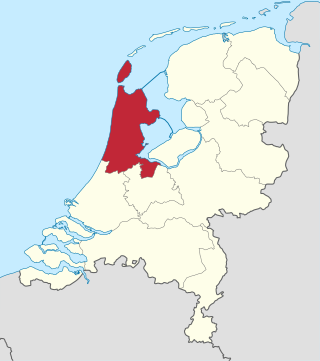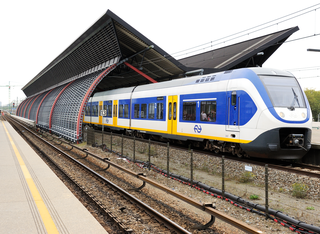
North Holland is a province of the Netherlands in the northwestern part of the country. It is located on the North Sea, north of South Holland and Utrecht, and west of Friesland and Flevoland. As of January 2023, it had a population of about 2,952,000 and a total area of 4,092 km2 (1,580 sq mi), of which 1,429 km2 (552 sq mi) is water.

Beemster is a former municipality in the Netherlands, in the province of North Holland. The Beemster is the first polder in the Netherlands reclaimed from a lake, the water extracted by windmills between 1609 and 1612. The original well-ordered landscape of fields, roads, canals, and dykes has been preserved intact. A grid of canals parallels the grid of roads in the Beemster. The larger feeder canals are offset by approximately one kilometer from the larger roads.

Purmerend is a city and municipality in the west of the Netherlands, in the province of North Holland. The city is surrounded by polders, such as the Purmer, Beemster and the Wormer. Purmerend's population grew relatively slowly until the 1960s, when it increased from around 10,000 to over 80,000 by 2020. This expansion has turned Purmerend into a commuter town; many inhabitants work, go to school or spend leisure time in Amsterdam. Purmerend is part of the Randstad, one of the largest conurbations in Europe.

Weesp is a city, an urban area in the municipality of Amsterdam in the province of North Holland, Netherlands. It had a population of 20,445 in 2021. It lies on the river Vecht and next to the Amsterdam–Rhine Canal in an area called the Vechtstreek. The former municipality of Weesp merged with Amsterdam on 24 March 2022.

GVB is the municipal public transport operator for Amsterdam, the capital of the Netherlands, operating metro, tram, bus and ferry services in the metropolitan area of Amsterdam.

The Amsterdam Metro is a rapid transit system serving Amsterdam, Netherlands, and extending to the surrounding municipalities of Diemen and Ouder-Amstel. Until 2019, it also served the municipality of Amstelveen, but this route was closed and converted into a tram line. The network is owned by the City of Amsterdam and operated by municipal public transport company Gemeente Vervoerbedrijf (GVB), which also operates trams, free ferries and local buses.
The Government of Amsterdam consists of several territorial and functional forms of local and regional government. The principal form of government is the municipality of Amsterdam, Netherlands. The municipality's territory covers the city of Amsterdam as well as a number of small towns. The city of Amsterdam is also part of several functional forms of regional government. These include the Waterschap of Amstel, Gooi en Vecht, which is responsible for water management, and the Stadsregio of Amsterdam, which has responsibilities in the areas of spatial planning and public transport.

Amsterdam Zuid is a railway station situated in the borough of Amsterdam-Zuid in Amsterdam, Netherlands. For a number of years, it was named Amsterdam Zuid WTC, in reference to the neighbouring World Trade Center Amsterdam. During 2006, in conjunction with the rapid development of the area surrounding the station, the station was enlarged and the reference to the WTC was formally dropped from the name.

Driemond is a village in the Dutch province of North Holland. It is a part of Weesp, an Urban area in the municipality of Amsterdam, Netherlands.

Weespstation is a railway station in Weesp, Netherlands. The station has two island platforms and a total of six tracks, two of which are used for passing trains. The Schiphollijn, Flevolijn and Gooilijn meet at Weesp making it an important transfer station for passengers going between Amsterdam, Hilversum and Almere. The first station in Weesp opened on 10 June 1874, when the Gooilijn from Amsterdam to Hilversum and Amersfoort was completed. The original station was demolished in 1967 and replaced by a new building. The new building partially went out of service in 1985 because of the new railway line from Weesp to Almere and beyond, called the Flevolijn. The out-of-service part was later converted to a bicycle parking and repair shop. The remaining station is little more than a tunnel passing under the tracks, and a small coffee counter. Train services are operated by Nederlandse Spoorwegen.
Philips Vingboons was a Dutch architect. He was part of the school of Jacob van Campen, that is, Dutch Classicism. Vingboons was especially highly regarded in his native city of Amsterdam.

Duivendrecht station (DVD) is a combined rail and metro station in Duivendrecht, Netherlands. The station opened on 23 May 1993 as part of the extension of the Zuidtak of the Amsterdam Ringspoorbaan, between Amsterdam RAI and Weesp. This station allows for the interchange between two grade-separated railways:

Amsterdam Muiderpoort is a railway station in the east of Amsterdam. It was reopened on 15 October 1939 after being first opened in 1896. It is located 4 km southeast of Amsterdam Centraal. At this station the Amsterdam–Arnhem railway and the Amsterdam–Zutphen railway split, with the two parts of the station separated (keilbahnhof). The western part is the Amsterdam Centraal to Utrecht Centraal line. The eastern part is the Amsterdam Centraal to Amersfoort Centraal line. The station is operated by the Nederlandse Spoorwegen.

Amsterdam RAI is a railway station situated in southern Amsterdam, Netherlands. It is located between the two directions of the A10 Amsterdam ring road. It is also a metro station at which GVB runs two lines. The station takes its name from the nearby RAI Amsterdam Convention Centre.

Almere Muziekwijk is a railway station in Almere, The Netherlands. It is located approximately 20 km east of Amsterdam. It is on the Weesp–Lelystad railway. The station was opened in 1987 when the line Weesp - Lelystad Centrum was built. In 1987 Almere Centrum and Almere Buiten stations opened before the Almere Buiten - Lelystad section was completed in 1988.

Almere Oostvaarders is a railway station in Almere, Netherlands. It is located 29 km (18.0 mi) east of Amsterdam, on the Amsterdam - Almere - Lelystad main line. It is approximately 3 km (1.9 mi) northeast of the Almere city centre. Almere Oostvaarders railway station opened on 12 December 2004.

The Metropolitan Region Amsterdam is the city region around the city of Amsterdam, the capital of the Netherlands. It lies in the Noordvleugel of the larger polycentric Randstad metropolitan area and encompasses the city of Amsterdam, the provinces of North Holland and Flevoland, as well as 36 further municipalities within the two provinces, with a total population of over 2.5 million inhabitants.

The boroughs of Amsterdam are the seven principal subdivisions of the municipality of Amsterdam, Netherlands. Each borough is governed by a directly elected district committee (bestuurscommissie). The first Amsterdam boroughs were created in 1981, with other boroughs created in later years. The last area to be granted the status of borough was Amsterdam-Centrum (2002). The existing system of seven boroughs, covering most parts of Amsterdam, is the result of a major borough reform in 2010. The current boroughs have populations of around 80,000 to 150,000, which is the equivalent to an average-sized municipality in the Netherlands. Since 2022, there is also the urban area Weesp.
The main public transport in the Netherlands for longer distances is by train. Long-distance buses are limited to a few missing railway connections. Regional and local public transport is by bus and in some cities by metro and tram. There are also ferries.

The Weesp train disaster took place on 13 September 1918 near Weesp, Netherlands. With 41 deaths and 42 injuries, it was the largest train disaster in Dutch railway history until the 1962 Harmelen train disaster.


















